Dive into the world of advanced AI with Gemini Pro, now accessible on Google AI Studio! This powerful tool opens a realm of possibilities for both text and image processing. Whether you’re an AI enthusiast, a developer, or just curious about the cutting-edge technology, Gemini Pro offers an intriguing adventure.
This guide will walk you through the essentials of Gemini Pro for text and its counterpart, Gemini Pro Vision. Get ready to unleash the full potential of AI in your projects and explore how Gemini Pro transforms your digital experience. Let’s embark on this journey together and discover the capabilities that await in Google AI Studio!
Setting Up Gemini Pro in Google AI Studio
Embarking on your journey with Gemini Pro in Google AI Studio is like unlocking a treasure trove of AI capabilities. Let’s break down the steps to get you started. It’s not just about clicking and typing; it’s about paving the way to a world where your creative and technical skills can truly flourish. So, grab your digital keys, and let’s get this set up!
Navigating to Google AI Studio
Accessing Google AI Studio is your first step. It’s pretty straightforward – just like walking into a digital playground. Here’s how to get there:
- Open your web browser and head to the Google AI Studio website.
- You’ll be greeted with a sign-in page. Use your Google account credentials to log in. No Google account? No problem! It’s easy to create one.
Agreeing to Play by the Rules
Once you’re in, you’ll encounter the terms and conditions. Think of these as the rules of the AI playground. Make sure you read through them carefully. Understanding this powerful tool goes beyond mere legalese; it involves using it responsibly. Once you’ve read and understood the terms, go ahead and accept them to proceed.
Obtaining Your Magic Wand: The API Key
The API key in Google AI Studio is like your magic wand. It’s what you’ll use to interact with Gemini Pro. Here’s how to get it:
- Look for the ‘Get an API Key’ button – it’s your gateway.
- Click on it, and a new window will pop up, guiding you through the process of creating your API key.
Choosing Your Path: New Project or Existing Cloud
Starting Fresh: New Project
If you’re new to this or want to start with a clean slate, creating a new project is your go-to option. Here’s how:
- In the API key generation window, select ‘Create API Key in New Project’.
- Follow the on-screen instructions to name and set up your new project. It’s like naming a newborn – choose wisely!
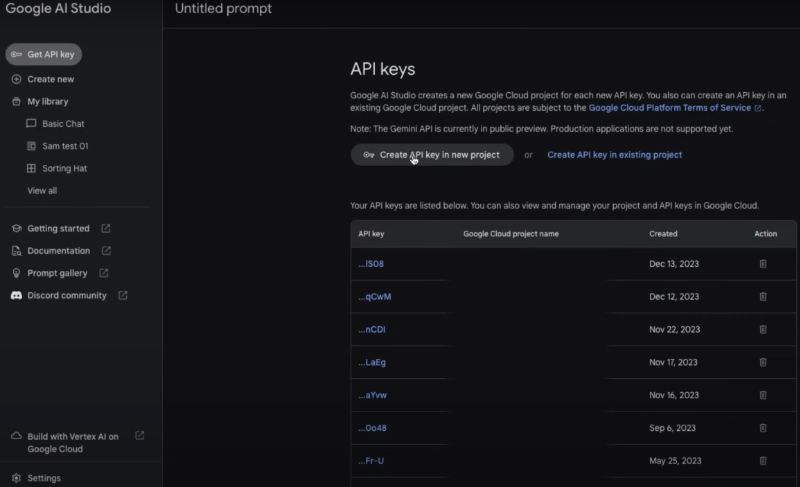
Tying It to Your Legacy: Existing Google Cloud Project
For the seasoned Google Cloud users, you might want to link this to your existing projects. It’s like adding a new chapter to your ongoing tech saga. Here’s the process:
- In the API key generation window, choose ‘Create API Key in Existing Project’.
- You’ll see a list of your current Google Cloud projects. Pick the one you want to integrate with Gemini Pro.
- Follow the steps to generate your API key within this project.
Using the API Key in Google CoLab
Alright, so you’ve got your shiny new API key for Gemini Pro in hand. It’s like having a secret code to an exclusive club, and now it’s time to use it where it really matters: in Google CoLab. CoLab is a fantastic tool that lets you write and execute Python in your browser. Think of it as your AI laboratory where you can experiment and bring your AI dreams to life. Let’s walk through how you can put that API key to work in Google CoLab.
Copying Your API Key: Hold onto Your Digital Passport
First thing’s first: you need to copy your API key from Google AI Studio. It’s like carefully copying a spell from an ancient grimoire. Here’s how to do it without any hocus pocus:
- After generating your API key in Google AI Studio, you’ll see an option to copy it. Click on that.
- Keep this key handy but secret. Treat it like your password. Maybe jot it down in a secure place or keep it on your clipboard for immediate use.
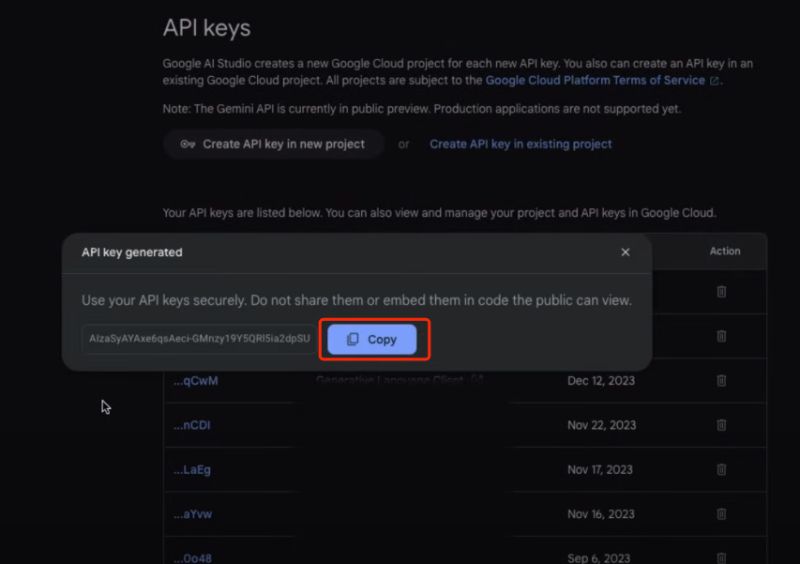
Setting Foot in Google CoLab
Next, let’s move to Google CoLab. If you’re new here, no worries; it’s user-friendly:
- Go to the Google CoLab website.
- Sign in with the same Google account you used for AI Studio.
Bringing Your API Key into Play
Now, you’re going to use this key to link your CoLab environment to Gemini Pro. Think of this as turning on the engine of your AI machine:
- Start a new notebook in CoLab. It’s like opening a fresh page in a wizard’s journal.
- In a new code cell, you’ll need to enter some code to authenticate your session with your API key.
- Type in the following Python code in the cell:
import os
os.environ["GOOGLE_AI_API_KEY"] = "YOUR_API_KEY"- Replace
YOUR_API_KEYwith the key you copied. Then, run the cell. This code essentially tells CoLab, “Hey, I’m a verified user with access to Gemini Pro. Let’s get rolling!”
Testing the Waters
After setting the API key, let’s do a quick test to make sure everything’s working:
- In a new code cell, write a simple code to call a function from Gemini Pro. It could be anything from generating text to analyzing an image.
- Run the cell and observe the output. If it works without errors, congrats! You’ve successfully harnessed the power of Gemini Pro in Google CoLab.
Exploring Gemini Pro and Gemini Vision Models
Welcome to the playground of Gemini Pro and Gemini Vision in Google AI Studio! Think of Gemini Pro as your digital wizard for text, and Gemini Vision as the maestro of images. Together, they offer a universe of possibilities. Let’s start by dipping our toes into these waters and see what kind of magic we can conjure up.
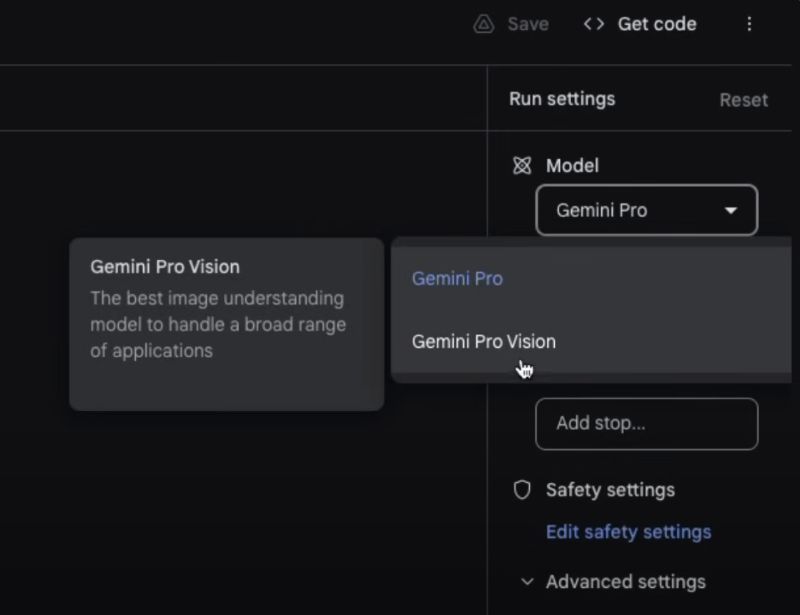
Crafting an Email with Gemini Pro
Let’s kick things off with a practical task: creating an email announcement. Imagine you want to share news about a product launch or an upcoming event. Here’s how Gemini Pro can help:
- In your Google CoLab notebook, write a Python script that uses Gemini Pro to generate text.
- Set the prompt to something like, “Write an email announcing the launch of our new product, the Eco-Friendly Water Bottle.”
- Run the script and watch Gemini Pro weave its words into a professional and engaging email.

The Versatility of Google AI Studio
Google AI Studio isn’t just a one-trick pony. It’s packed with versatility:
- Freeform Prompts: Think of these as open-ended questions. You can ask Gemini Pro anything, and it’ll come up with creative responses.
- Structured Prompts: These are more like fill-in-the-blanks. You provide a template, and Gemini Pro fills in the specifics.
- Chat Prompts: Want to simulate a conversation? Chat prompts let you interact with Gemini Pro as if you’re texting a friend.

Customizing Prompts and Responses
Now, let’s talk about making Gemini Pro dance to your tune. Customizing prompts and responses is where your creativity really gets to shine.
Running and Modifying Prompts
Running prompts in Gemini Pro is like directing a play. You set the scene, and Gemini Pro performs:
- In CoLab, start with a basic prompt.
- Run the script and observe the response.
- Want to tweak it? Change the prompt slightly for a different angle or more specific answer. It’s like guiding an actor to perfect their performance.
Safety First: Adjusting Settings and Filters
Safety settings and content filters are crucial, especially if you’re generating content for a wider audience. Here’s how to adjust them:
- In Google AI Studio, look for the safety settings option. It’s like setting the rules for what’s allowed on stage.
- You can choose to block or allow certain types of content: think hate speech, explicit material, etc.
- Adjust these settings based on your needs. It’s about finding the balance between creative freedom and responsible output.
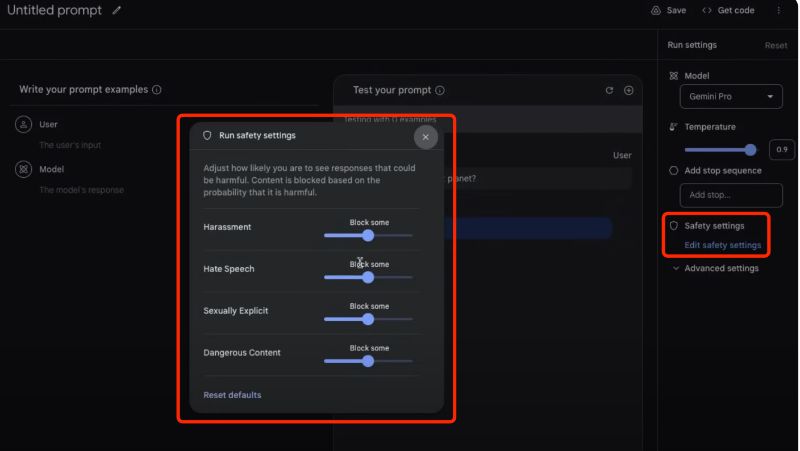
Diving Into the Code: Setting Up and Using Gemini Pro Models
Ready to get your hands dirty with some coding magic? Let’s dive into the nitty-gritty of setting up and using Gemini Pro models in Google CoLab. It’s like being a chef in a kitchen, but instead of food, you’re cooking up some AI wonders!
Setting Up Your AI Kitchen: Laying the Foundation
Before you start whipping up AI creations, you need to set up your environment in CoLab:
- Initialize the Environment: Open a new notebook in CoLab and import necessary libraries. Think of it as gathering your cooking utensils.
- Authenticate with API Key: Remember the API key you got earlier? Use it here to authenticate your session.
Cooking Up Some Content: Generating Your First AI Dish
Now, let’s generate some content:
- Choose Your Model: Decide whether you want to use Gemini Pro for text or Gemini Vision for images.
- Craft Your Prompt: Write a prompt or question for the model. It’s like choosing a recipe to follow.
- Execute and Observe: Run the code and watch as the model generates a response. It’s like waiting for your dish to cook – exciting!
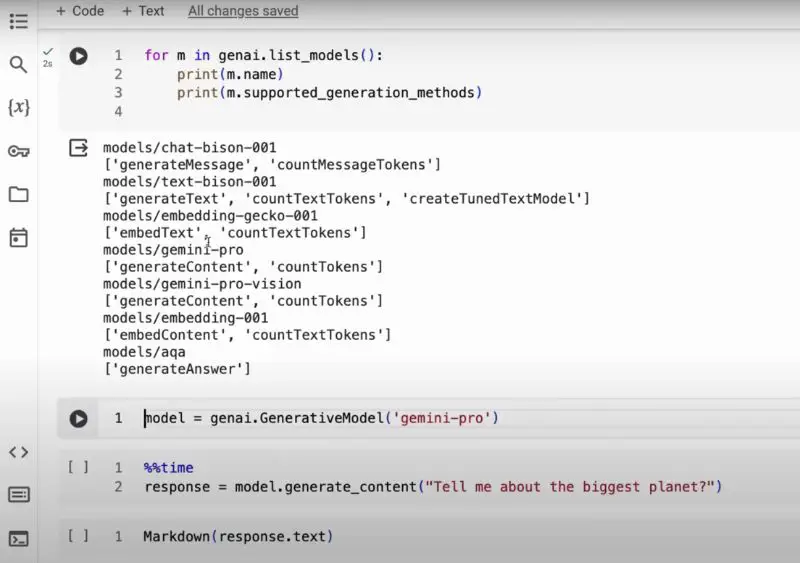
Advanced Features of Gemini Pro
Ready to add some spices and secret ingredients to your AI dishes? Let’s explore the advanced features of Gemini Pro.
Turning Up the Heat: Advanced Settings
These settings are like adjusting the heat and seasoning in cooking:
- Temperature: Controls the ‘creativity’ of responses. Higher temperature means more creative, but less predictable results.
- Top P: It’s like a filter that decides how many possibilities the model considers before responding.
- Top K: Limits the number of highest probability options the model considers.
- Output Tokens: Sets the length of the response. Longer output tokens mean more detailed responses.
Safety Settings: Customizing the Filters
Just like how you’d handle knives and fire in the kitchen, handling content in AI needs care:
- Set Content Filters: Decide what kind of content is off-limits. This could include explicit language, sensitive topics, etc.
- Adjust the Strength: You can set how strict these filters are. It’s about keeping your AI outputs family-friendly and professional.
Practical Examples of Model Use
Now, let’s put our skills to the test with some practical examples.
Responding to the Audience: Generating Specific Responses
- Use Structured Prompts: For example, ask Gemini Pro to write a product description or a blog intro.
- Run and Review: Execute the code and review the responses. Each execution is like a new dish coming out of the oven – unique and interesting.
The Art of Conversation: Using the Chat Model
- Set Up a Chat Scenario: Initialize a chat session with Gemini Pro. It’s like setting up a stage for a dialogue.
- Exchange Messages: Send messages and let Gemini Pro respond. It’s a back-and-forth interaction, almost like texting a friend.
Quality Control: Handling Prompt Feedback and Safety Checks
- Review Prompt Feedback: After each response, check the feedback from the model. It’s like tasting your dish to ensure quality.
- Adjust as Needed: If the content isn’t what you expected, tweak the prompt or settings. It’s all about refining your recipe until it’s just right.

Exploring Gemini Pro-Vision for Image Analysis
If Gemini Pro is the master of text, think of Gemini Pro-Vision as the wizard of images. This section is all about unlocking the potential of image analysis with some AI flair.
Unraveling the Magic of Gemini Pro-Vision
Gemini Pro-Vision is like having an extra set of super-smart eyes. It’s designed to analyze and understand images in ways that might even surprise you. From recognizing objects to interpreting complex scenes, this tool is a game-changer in image analysis.
Practical Spells: Image Analysis and Visual Q&A
Let’s put Gemini Pro-Vision to the test. Think of an image you want to analyze – maybe it’s a street scene or a picture of a historical monument. Here’s what you can do:
- Upload the image to your Google CoLab notebook.
- Use Gemini Pro-Vision to analyze it. The model can identify elements in the image, provide descriptions, or even guess the context.
Visual question answering is like having a conversation about a picture. You can ask questions like, “What’s the tallest building in this image?” or “What breed is the dog in the picture?” Gemini Pro-Vision will provide answers based on what it sees.

Advanced Usage of Gemini Pro-Vision
Let’s take it to the next level and delve into advanced applications of Gemini Pro-Vision. Here, we’re venturing into the realm where you can truly push the limits of image AI capabilities.
Multiple Images, Multiple Discoveries
Using Gemini Pro-Vision with multiple images opens up a whole new world of possibilities. Imagine comparing two pieces of art or different species of birds. Here’s how to do it:
- Upload two or more images to CoLab.
- Use Gemini Pro-Vision to run a comparative analysis. It can highlight differences, similarities, and unique characteristics of each image.
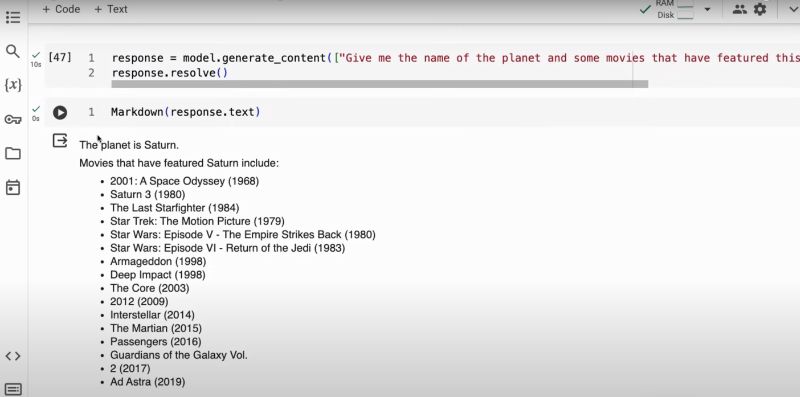
Uncovering the Hidden Details
Sometimes, the magic is in the details. Gemini Pro-Vision can dive deep into images, offering detailed analysis that might miss the human eye. It’s like having a magnifying glass that not only zooms in but also explains what it sees.
Conclusion and Future Directions
That’s a wrap! We’ve journeyed through setting up Gemini Pro, using API keys in Google CoLab, and delved into the magic of Gemini Pro and Pro-Vision models. We’ve seen how to tailor prompts and dived into advanced image analysis.
Now it’s your turn to play and innovate. Grab your API key and explore the possibilities in CoLab. Keep experimenting and stay curious. The AI world is constantly evolving, and so can you. Here’s to your creative adventures with AI! 🚀🤖
Resources:
- Colab: https://colab.research.google.com/drive/1W5UkUpjNK9wi7RzuEv83vC0ejBgJ5Ty3
- Github: https://github.com/samwit/langchain-tutorials
- Google AI for Developers: https://ai.google.dev/
